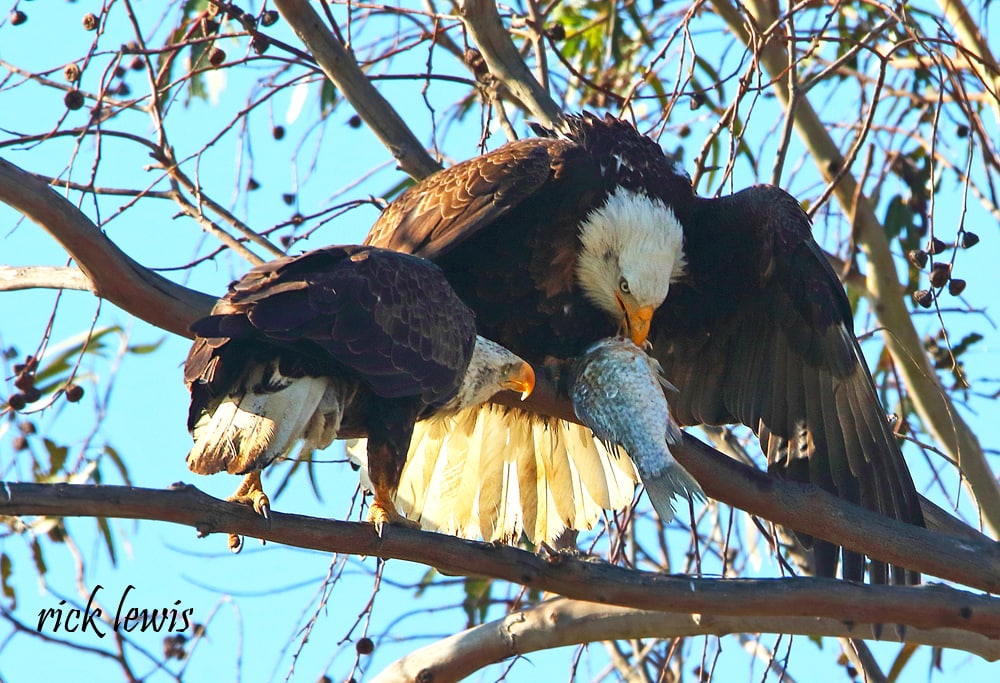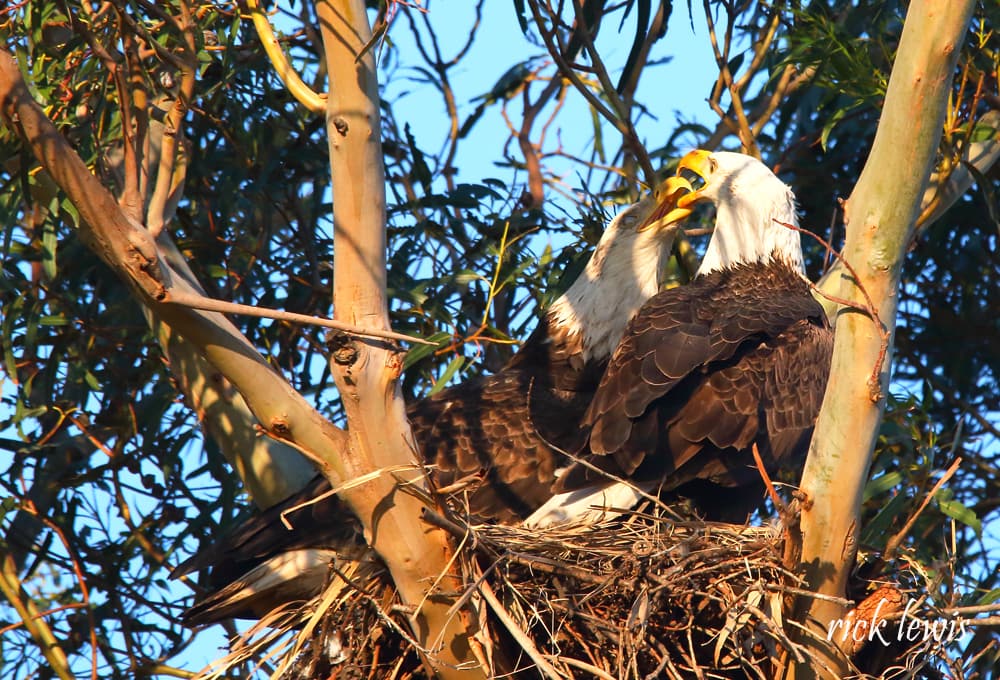RESILIENCE – Bald Eagles of Corica Park
By Rick Lewis
The news is out. The Alameda Bald Eagles’ nest at Corica Park suffered significant damage during the recent storm on Tuesday, March 21. The eggs were lost and the nest is tilting, but there are good signs of recovery and current behavior points to incredible resilience demonstrated by our esteemed pair.
For 100 (RL) days out of the last 109, since the nest was discovered on December 29, 2022, I have been monitoring the nest for Golden Gate Bird Alliance and Corica Park Management. What a wild and fantastic ride it has been!
From the beginning there has been tremendous interest in this pair. Astonishment was registered, questions were asked, location was discussed, verification ensued, and finally, complete awe and wonder was acknowledged. Birders, photographers, and journalists flocked to the site for a first-hand look at this phenomena unheard of for many, many years. In fact, according to the California Department of Fish and Wildlife, there is no known record of Bald Eagles nesting in the city of Alameda.

A major part of this story is our female. Born in 2019 (2018 RL) in Milpitas at Curtner Elementary School, Big Jr.’s history is an amazing stand-alone story and we continue to be impressed by her enduring legacy. Young eagles face many dangers. Big Jr. lost a talon on her right foot. While eagles use their talons to capture and carry their food, Big Jr. seems to be able to hunt with no problems. I have seen her catch and eat carp, seagulls, and American Coot. Together, the pair have been observed eating gophers, ground squirrels as well and occasionally, carrion. Unfortunately her lost talon is not the only injury she’s had to overcome. When a hiker reported an injured bird, Craig Nikitas and a crew from Bay Raptor Rescue captured Big Jr. and took her to Lindsay Wildlife Experience’s Wildlife Hospital. The young Big Jr. had a broken shoulder bone and bruising on her back. After rehabilitating her, they released her into a local park. You can see Craig Nikitas holding just-rescued Big Jr., wrapped in a towel, at: https://koi-goose-xfgr.squarespace.com/new-page-67.
Her brother was not so lucky; he died from injuries received when he flew into a high-voltage power line while learning the many flight skills eagles need to hunt successfully and eventually build and defend a nest. Risks posed by an urban environment, like power lines and toxins in the environment, add to the natural dangers faced by young birds. Only about half of all Bald Eagle chicks survive their first year and others don’t survive to adulthood.
More details about Big Jr.’s early years can be found at Big Junior, An Alameda Bald Eagle’s Story (alamedapost.com). We know where Big Jr. hatched because of a Facebook group that follows, and takes pictures of eagles nesting in the Bay Area – Bay Area Eagles. Their postings include pictures of the Corica eagles as well as several other eagles.
Throughout this cold, rainy and particularly windy winter, people throughout Alameda have been concerned about how the eagles are doing. The eagles and their nest persevered through many a wind episode, but the wind at the course on March 21 was particularly fierce.
The morning of March 22 arrived. I met with Vinny Paul, Corica Park Maintenance Superintendent, pre-dawn and we saw the nest tree was still standing. That was good news. We decided that more light was needed to fully inspect the area. I went home for more coffee and returned to meet with another Golden Gate Bird Alliance monitor, Doug Henderson.
Devastation, sadness and disbelief. The eggs were gone. The eagles were flying about seemingly agitated. Incubating posture ceased. Variables, consequences, behavior, questions, next steps, and the idea that anything could happen were all discussed. Would the eagles completely abandon the area? Was the nest at all salvageable?

Fortunately, the eagles have been observed on their second nest located on the opposite side of the golf course. The Golden Gate Bird Alliance eagle monitors continue their survey of the site and behavior and are providing encouraging reports of the eagles’ continued intrepidity. While they were still recovering from the first nest damage, an interloper decided to make some trouble. A juvenile Bald Eagle was seen harassing the pair and was driven off. The eagles’ residence at Corica Park has certainly been challenging for them but they have demonstrated a lot of resilience, and we are hopeful they will continue here.

The fact that Big Jr. hatched in March of 2019 (2018 RL) highlights one of the problems now facing the pair at Corica Golf Course; it is late in the breeding season. The Bald Eagles that nest in the East Bay typically lay their eggs in February or March, and incubate them for about 35 days, or five weeks. The adults then feed the nest-bound chicks for 11 to 12 weeks, by which time the young birds are ready to try their wings. Fledglings, however, must still be fed, as they learn to hunt and capture their own food. After she lays eggs, a female Bald Eagle has another four months or so of work to send fledglings off to explore on their own. While eagles normally raise only one brood, some females lay another set of eggs three to four weeks after eggs are removed from the nest.
In other words, if Big Jr. lays a second clutch of eggs in early April, assuming no new problems, they would hatch in early May and the chicks would fledge in mid-August. Bald Eagles in Florida and in the Yellowstone area lay eggs as late as mid-April and successfully fledge young. Normally, East Bay weather should not be too hot for the chicks through July and early August and the San Leandro Bay should provide enough fish and small mammals to feed the adults and chicks through the summer. Given Big Junior’s history to date and our 2023 weather, “no new problems” may be a big assumption, but both her resilience and long-range weather forecasts may give watchers some hope.
If I’m honest, there is one more worry. Big Junior is just barely four years old. The general consensus is that female Bald Eagles can breed at five years, but there are reports of three- and four-year-old females successfully raising chicks. We did see evidence of eggshells in the fallen nest, but there’s no way to know if those eggs were viable. One more thing to worry about over the next few weeks.
The eagles have also created a greater sense of community interest that is generating a tremendous positive fabric. It is spring and we expect and hope the wind and rain will subside.
We look forward to seeing you and the eagles in good weather with wings out soaring over Alameda.
Rick Lewis is a long time GGBA & National Audubon member and other environmental organizations. He contributes photographs & volunteers often to Bay Area and Central Valley birding groups that promote wildlife & habitat conservation.
